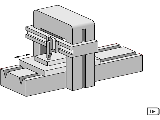[172] Exercise: Planing machine (by-pass circuit)
 The sliding bed of a
parallel planing machine is actuated with the aid of a hydraulic
control system. The power section of this hydraulic control
system consists of a double acting differential cylinder. The
area ratio of the full piston surface of this cylinder to the
annular piston surface is 2:1. Since the piston-rod chamber is
only half the volume of the piston chamber, the return stroke is
twice as fast as the advance stroke. Machining has previously
been carried out only during the advance stroke. In future,
working movements are to be carried out in both directions. To
make this possible, the hydraulic control system must be modified
so that forward and return strokes are at the same speed. The
speed should now also be adjustable. The connecting lines should
be added to the given circuit diagram. The mode of operation of
the circuit in the three switching positions should be described
and the various piston speeds and forces compared.
The sliding bed of a
parallel planing machine is actuated with the aid of a hydraulic
control system. The power section of this hydraulic control
system consists of a double acting differential cylinder. The
area ratio of the full piston surface of this cylinder to the
annular piston surface is 2:1. Since the piston-rod chamber is
only half the volume of the piston chamber, the return stroke is
twice as fast as the advance stroke. Machining has previously
been carried out only during the advance stroke. In future,
working movements are to be carried out in both directions. To
make this possible, the hydraulic control system must be modified
so that forward and return strokes are at the same speed. The
speed should now also be adjustable. The connecting lines should
be added to the given circuit diagram. The mode of operation of
the circuit in the three switching positions should be described
and the various piston speeds and forces compared.
In order to achieve the same speed on the advance and return strokes, a differential circuit (by-pass circuit) can be used with differential cylinders with an area ratio of 2:1. Picture 116.2 The second picture shows the principle of a by-pass circuit with a 3/2-way valve. In the case of the parallel planing machine, the necessary differential circuit can be achieved by using the mid-position of a 4/3-way valve (A, B and P connected, T closed). In this switching position (advance stroke), the piston speed and force are twice as high as in the right-hand switching position (return stroke). In the left-hand switching position, on the other hand, the advance stroke is half as fast and the force twice as great as in the other two switching positions. The speed for the advance and return strokes can be adjusted by means of a flow control valve fitted upstream.
It should also be noted that only half the force is available on the advance stroke at the mid-position. In the case of a tractive load, the by-pass position has the advantage that the piston is hydraulically clamped. Differential circuits are used not only as synchronization circuits but also as rapid-traverse circuits when, for example, different speeds are required in the same direction with constant pump delivery. If it is desired to calculate forces and piston speeds using concrete values, the model values given in the TP 501 textbook can be used for this purpose.

